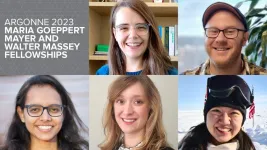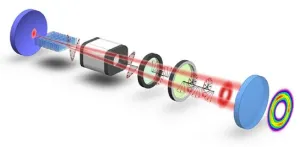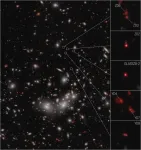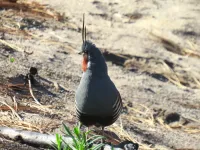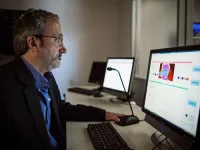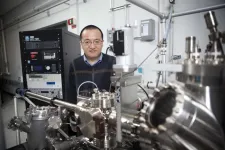(Press-News.org) The U.S. Department of Energy’s (DOE) Argonne National Laboratory has awarded its newest cohort of named fellowships, providing five early-career scientists with additional support as they pursue pivotal discoveries that will make Americans safer and better off and increase our understanding of the universe.
For 2023, the laboratory has named four Maria Goeppert Mayer Fellows and one Walter Massey Fellow. Maria Goeppert Mayer was a pioneering nuclear physicist who received the 1963 Nobel Prize in physics for discovering, at Argonne, the shell model of the atomic nucleus. Walter Massey is a leading African American scientist and executive who served as Argonne’s director in the 1980s and has served as the president of Morehouse College and the School of the Art Institute of Chicago.
The Maria Goeppert Mayer Fellows are James Cornelison, Vrindaa Somjit, Mary Elizabeth Wagner and Cyndia Yu. The Walter Massey Fellow is Amanda Carr.
“With its leadership in the science community and powerful user facilities and tools, Argonne is an exceptional place to start a research career. We welcome the latest Goeppert Mayer and Massey Fellows, who will contribute to our many real-world impacts that accelerate the science that drive U.S. prosperity and security,” said Argonne Director Paul Kearns.
Cornelison is a graduate student and research fellow at the Harvard-Smithsonian Center for Astrophysics. He is a U.S. Marine turned astrophysicist studying experimental cosmology. His work has been in developing new instruments and detectors that enable cosmological telescopes at the South Pole to discover signals of new physics in the early universe. His thesis work has involved looking at signals received from the cosmic microwave background (CMB) for cosmic inflation and other exotic physical models.
Cornelison has focused on hands-on instrumentation design that involves building high-precision RF calibration sources and using them to characterize instrumental systematics of the BICEP3 and BICEP Array telescopes. As a Maria Goeppert Mayer fellow, his goal is to produce high-performance detector solutions in time for the next phase of cosmological experiments in which Argonne is a contributor, such as SPT-3G+ and CMB-S4.
Somjit has been a postdoctoral researcher in Argonne’s Materials Science division since 2022, where she studies the design of qubits in oxides using first principles methods. She received her Ph.D. in May 2022 in materials science and engineering from the Massachusetts Institute of Technology (MIT). Her research interests include using computational techniques to tune defects in materials to achieve desired quantum properties. In the past, she has used this approach to design materials for corrosion barriers and neuromorphic computing devices.
For her fellowship, Somjit will work to identify spin qubits in oxides and their synthesis routes by developing and utilizing a variety of simulation techniques on both classical and quantum computers. Through this project, she plans to contribute to the development of scalable quantum information networks and also develop workflows for realistic and accurate materials simulations.
Wagner is a research scientist with the U.S. Department of Defense. She received her doctorate in 2021 from MIT, where she developed novel thermodynamic models to describe the relationship between electrolytes and electrodes, and demonstrated ways to use these models to streamline experimentation and screen new battery chemistries. Her other research efforts included sulfur dioxide emissions-free production of copper via molten sulfide electrolysis and processing rare earth machining sludge to reclaim rare metals. Her primary research motivation has always been to enable processing of metals in a way that reduces both environmental cost and supply-chain risk.
Wagner’s research plans include investigating sustainable rare-earth and lithium metal production, and using her unique approach to combine modeling and experimentation to better understand the fundamental behavior of complex chemistries in high-temperature environments.
Yu is a graduate student at Stanford University working on novel instrumentation and analysis for CMB surveys. She is involved with the BICEP/Keck, Simons Observatory and CMB-S4 experiments in making ever more sensitive measurements of the CMB to probe a wide range of cosmological questions.
As a Maria Goeppert Mayer fellow, Yu will seek to leverage Argonne’s superconducting nanofabrication facilities in order to develop ultrasensitive detectors and readouts for astroparticle applications. In particular, she is interested in exploring synergies between particle physics, cosmology and quantum sensing to build the next generation of instruments for CMB surveys.
Walter Massey Fellow Carr has been a postdoctoral researcher at Argonne since 2020. Since coming to Argonne, she’s studied graphene-based rare earth separations using interface-specific X-ray scattering and spectroscopy techniques. Her fellowship research will focus on understanding the fundamental interactions between the different components of graphene oxide nanocomposite membranes for improved lanthanide and actinide separations.
In graduate school, Carr worked on X-ray and interfacial characterizations of graphene and other nanocomposites. Her infrared reflection adsorption spectroscopy measurements on graphene-polymer laminar composites, the first of their kind, netted her a nomination for the Physical Electronics Conference’s Nottingham Prize, where she finished as a finalist in 2020. In 2021, the Journal of Physics: Condensed Matter named her an Emerging Leader defined by the editorial board as one of “the most talented and exciting researchers in their generation.” Carr has received multiple outstanding presentation awards from both Brookhaven and Argonne national laboratories, as well as a Graduate Assistance in Area of National Need Fellowship from the U.S. Department of Education during her Ph.D. work.
“These fellows represent the future of science,” said Matthew Tirrell, Argonne interim deputy laboratory director for science and technology. “They have great potential to achieve pivotal discoveries. They will confront some of the most pressing technological questions facing society and lay the foundation for next-generation advancement.”
Argonne National Laboratory seeks solutions to pressing national problems in science and technology. The nation’s first national laboratory, Argonne conducts leading-edge basic and applied scientific research in virtually every scientific discipline. Argonne researchers work closely with researchers from hundreds of companies, universities, and federal, state and municipal agencies to help them solve their specific problems, advance America’s scientific leadership and prepare the nation for a better future. With employees from more than 60 nations, Argonne is managed by UChicago Argonne, LLC for the U.S. Department of Energy’s Office of Science.
The U.S. Department of Energy’s Office of Science is the single largest supporter of basic research in the physical sciences in the United States and is working to address some of the most pressing challenges of our time. For more information, visit https://energy.gov/science.
END
Argonne names newest Maria Goeppert Mayer and Walter Massey Fellows
Five early-career scientists appointed to prestigious postdoctoral research positions
2023-04-24
ELSE PRESS RELEASES FROM THIS DATE:
Generation of color-tunable high-performance LG laser beams via Janus OPO
2023-04-24
Laguerre-Gaussian (LG) modes are a type of light wave that can carry the external torque of photons as they move through space. They are useful in many fields, from optical communications to super-resolution imaging. Advanced developments in these and other applications demand reliable and color-tunable LG mode laser sources, which do not yet exist.
An optical parametric oscillator (OPO) is a device that can generate a wavelength-tunable laser beam, so it has been used to realize a color-tunable LG laser source — generally, in one of two ways. One way is to change a regular beam into an LG beam using a phase component ...
Webb reveals early-universe prequel to huge galaxy cluster
2023-04-24
Every giant was once a baby, though you may never have seen them at that stage of their development. NASA’s James Webb Space Telescope has begun to shed light on formative years in the history of the universe that have thus far been beyond reach: the formation and assembly of galaxies. For the first time, a protocluster of seven galaxies has been confirmed at a distance that astronomers refer to as redshift 7.9, or a mere 650 million years after the big bang. Based on the data collected, astronomers calculated the nascent cluster’s future development, finding that it will likely grow in size and mass to resemble the Coma Cluster, ...
Study: Mountain quail may benefit from high severity wildfire
2023-04-24
Ithaca, NY--Mountain Quail are an under-studied but recreationally-valued management indicator species in California's Sierra Nevada. They are notoriously difficult to study due to their penchant for impenetrable, dense, shrubby habitats, high elevations, and steep slopes. In this study, researchers used 1,636 autonomous recording units across about 22,000 square kilometers to conduct the first ever systematic and comprehensive study of Mountain Quail habitat associations and fire ecology in the Sierra Nevada.
Researchers from the Cornell Lab of Ornithology, the University of Minnesota, Univesity of Wisconsin-Madison, and the ...
Keeping a tighter rein on blood pressure in adults over 50 is desirable for brain health
2023-04-24
SAN ANTONIO (April 24, 2023) — Intensive blood pressure treatment significantly reduces the risk of adverse cerebrovascular events such as stroke. New research from The University of Texas Health Science Center at San Antonio (UT Health San Antonio) shows evidence of how the brain benefits from consistently lower blood pressure.
The study, published March 1 in JAMA Network Open, is a follow-up analysis of the Systolic Blood Pressure Intervention Trial (SPRINT), a multicenter clinical trial that compared intensive systolic blood pressure control ...
Fear not the deadlines, new research finds
2023-04-24
Deadlines are part and parcel of modern knowledge work. Journalists must serve their weekly columns, managers must turn in their monthly reports, and researchers must submit their papers and proposals on time. Despite their ubiquity, deadlines conjure up negative feelings and are perceived as challenging events. Accordingly, there has been a trend to do away with deadlines, where possible. For instance, the National Science Foundation (NSF) in the United States introduced no-deadline submissions in some of its funding programs. Critics, however, have been arguing that although deadlines may be painful, they are necessary, because they motivate people to act.
Researchers from the University ...
Winter cover crops could reduce nitrogen in Illinois drainage water by 30%
2023-04-24
URBANA, Ill. – As Corn Belt states seek ways to curb nitrogen flow from farms into the Gulf of Mexico, new University of Illinois research adds evidence for winter cover crops as an important part of the solution. A simulation study published in Science of the Total Environment finds widespread planting of cereal rye in Illinois could reduce nitrate in the state’s tile drainage water by 30%.
The research team, part of the College of Agricultural, Consumer and Environmental Sciences (ACES) and The Grainger ...
Mount Sinai launches Institute for Regenerative Medicine
2023-04-24
Regenerative medicine—the process of replacing, engineering or regenerating human cells, tissues or organs—holds exciting potential for the field of health care. It could someday make it possible to grow a new kidney in a petri dish, repair damaged nerve cells, or reverse memory loss.
Continuing a commitment to advance medicine through forward-thinking approaches and groundbreaking discoveries, the Icahn School of Medicine at Mount Sinai is announcing the creation of the Institute for Regenerative Medicine to foster innovative research into new pathways to cure ...
Researchers team up with national lab for innovative look at copper reactions
2023-04-24
BINGHAMTON, N.Y. -- Researchers at Binghamton University partnered with the Center for Functional Nanomaterials (CFN) — a U.S. Department of Energy Office of Science User Facility at Brookhaven National Laboratory — to get a better look at how peroxides on the surface of copper oxide promote the oxidation of hydrogen but inhibit the oxidation of carbon monoxide, allowing them to steer oxidation reactions.
They were able to observe these quick changes with two complimentary spectroscopy methods that have not been used in this way. The results of this work have been published in the journal Proceedings ...
New report provides insight into the library’s evolving role in student success
2023-04-24
A new Technology from Sage report sheds light on challenges in the librarian-patron relationship, including the need for greater digital literacy and more tailored support for students, and recommends methods to support the student experience. “The Knowledge Gap Between Librarians and Students: Contrasting Librarian and Student Perspectives on the Undergraduate Workflow” report is the second in the Librarian Futures series.
A survey of nearly 600 students in the US, UK, and Canada highlights key findings for librarians across the undergraduate workflow — specifically ...
Understanding the long-term impact of climate change on Indian crops
2023-04-24
Over the past few decades, it has become obvious that climate change, and consequent extreme weather events, can wreak havoc on crop yields. Concerningly, there is a large disparity in agricultural vulnerability between developed and developing countries. In a new study, researchers have looked at major food grains in India to understand the long- and short-term effects of climate change on crop yields.
“Most studies that measure the effects of climate change are looking at year-to-year changes, which are representative of variations in weather and not climate,” said Madhu Khanna (CABBI), a professor of agriculture ...
LAST 30 PRESS RELEASES:
Orthopedics can play critical role in identifying intimate partner violence
Worms as particle sweepers
Second spider-parasitic mite described in Brazil
January 2026 issues of APA journals feature new research on autism, pediatric anxiety, psychedelic therapy, suicide prevention and more
Private equity acquired more than 500 autism centers over the past decade, new study shows
New cervical cancer screening guidelines from the US Department of Health and Human Services
Estimated burden of COVID-19 illnesses, medical visits, hospitalizations, and deaths in the US from October 2022 to September 2024
Smartphone use during school hours by US youth
Food insecurity and adverse social conditions tied to increased risk of long COVID in children
Earliest, hottest galaxy cluster gas on record could change our cosmological models
Greenland’s Prudhoe Dome ice cap was completely gone only 7,000 years ago, first GreenDrill study finds
Scientific validity of blue zones longevity research confirmed
Injectable breast ‘implant’ offers alternative to traditional surgeries
Neuroscientists devise formulas to measure multilingualism
New prostate cancer trial seeks to reduce toxicity without sacrificing efficacy
Geometry shapes life
A CRISPR screen reveals many previously unrecognized genes required for brain development and a new neurodevelopmental disorder
Hot flush treatment has anti-breast cancer activity, study finds
Securing AI systems against growing cybersecurity threats
Longest observation of an active solar region
Why nail-biting, procrastination and other self-sabotaging behaviors are rooted in survival instincts
Regional variations in mechanical properties of porcine leptomeninges
Artificial empathy in therapy and healthcare: advancements in interpersonal interaction technologies
Why some brains switch gears more efficiently than others
UVA’s Jundong Li wins ICDM’S 2025 Tao Li Award for data mining, machine learning
UVA’s low-power, high-performance computer power player Mircea Stan earns National Academy of Inventors fellowship
Not playing by the rules: USU researcher explores filamentous algae dynamics in rivers
Do our body clocks influence our risk of dementia?
Anthropologists offer new evidence of bipedalism in long-debated fossil discovery
Safer receipt paper from wood
[Press-News.org] Argonne names newest Maria Goeppert Mayer and Walter Massey FellowsFive early-career scientists appointed to prestigious postdoctoral research positions
